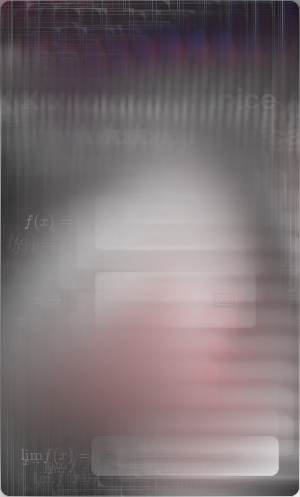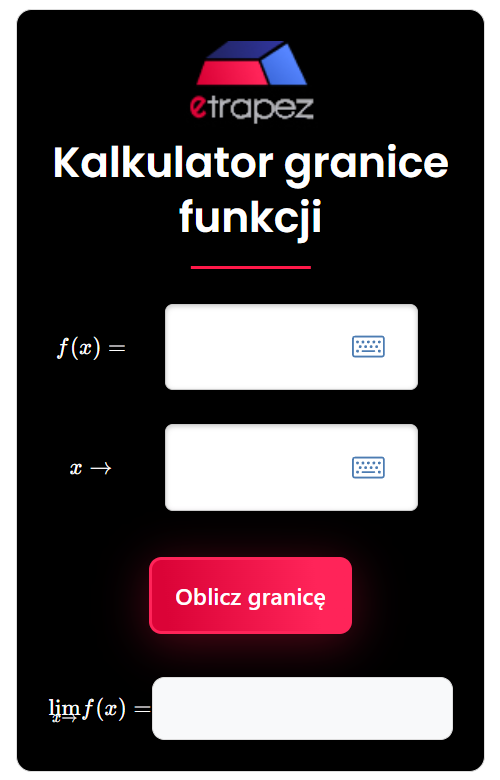Ogłoszenie
Niestety, po ponad 12 latach od udostępnienia przeze mnie darmowego kalkulatora do granic funkcji, musiałem go “wyłączyć”.
Kalkulator był prostym “widgetem” strony WolframAlpha. Jakiś czas temu Wolframalpha zmienił swoją politykę odnośnie widgetów. Między innymi: przestały one obliczać “na miejscu”, tylko przerzucają użytkownika na stronę WolframAlpha .
Przepraszam za kłopot wszystkich dotychczasowych użytkowników Kalkulatora Do Granic Funkcji.
Nowy kalkulator granic funkcji
Zapraszam też do nowego kalkulatora granic funkcji, stworzonego już przeze mnie w technologii Open Source. Dostęp do niego oraz do innych interaktywnych narzędzi możecie uzyskać w ramach subskrypcji za jedyne 5,99 zł / miesiąc (lub taniej w opcjach kilkumiesięcznych) na stronie:
A sam kalkulator wygląda tak:
Pozdrawiam i powodzenia!
Krystian Karczyński




75 Komentarzy
Abdul
Męczę się długo z tym przykładem i nie ma pojęcia jak go zrobić. Dlaczego w: „lim x dąży do nieskończoności: e^x-x^2″=nieskończoność?
f(x)=xarccos(x/(1-x)) x->1-
co oznacza ioo w wyniku granicy
Bardzo proszę o rozwiązanie granicy funkcji: lim x->1 lnx * cos( π/x-1)
Błażej
Mam problem z jedną granicą, wyszło mi 0 a robiłem ten przykład metodą mnożenia przez sprzężenie, natomiast na kalkulatorze pokazuje że dąży do nieskończoności.
lim x->oo x \sqrt(3) – \sqrt(3n^2+8)
Natalia
Czy da się wpisać w kalkulator PI/2? Bo samo PI działa, a przez 2 na żaden sposób nie chce obliczyć nie rozumie
Krystian Karczyński
Mi PI/2 działa… A jaka jest cała formuła i do czego ma dążyć x?
Kuba
Witam pomoże ktoś z granicą:lim x->PI/2 (tgx)^1/(x-PI/2) ?
dm
Czy ktoś pomoże z taką granicą: lim x->oo (((sinx)^2)*lnx)/(x^1/3)
wojtek
A jak obliczyć granice lim x->0+ 2x*ln(arcsinx)
Paweł
Dobry Wieczór. Przygotowuje się do kolokwium i chciałbym policzyć jedną granicę, a na kalkulatorze wychodzi jakiś dziwny wynik. Raz zero, raz nieskończoność. Przykład:lim przy x -> nieskończoność (3n+7/3n-2)^-4n
Asia
Witam! Potrzebuję pomocy : lim x->o x^x
Ania
Dzień dobry! Pilnie potrzebuję pomocy z jednym przykładem. Liczę i liczę, a doliczyć się nie mogę.Z gory dziękuję za pomoc 🙂 lim x->oo (x-lnx)
Anna Zalewska
https://www.youtube.com/watch?v=wg4hVSerxPQ
WojciechK
Witam! Potrzebuję natychmiastowej pomocy z jednym przykładem. Męczę się strasznie, lecz nie mogę go zrobić. Moja profesorka jest straszna. Z góry dziękuję za pomoc.
Joanna Grochowska
Granica ta tylko na pierwszy rzut oka wydaje się straszna 🙂
Wystarczy zauważyć taki myk, że występują tutaj po prostu liczby do potęgi „x”. Liczbę e jak i można potraktować na równi jakby stała tam
można potraktować na równi jakby stała tam  czy
czy  . W takich sytuacjach postępuje typowo, czyli wyciągam przed nawias największe potęgi z licznika i mianownika, pamiętając, że
. W takich sytuacjach postępuje typowo, czyli wyciągam przed nawias największe potęgi z licznika i mianownika, pamiętając, że  oraz
oraz 
Teraz więc w granicy da
więc w granicy da  . Pozostałe wyrażenia podniesione do potęgi x dążą do
. Pozostałe wyrażenia podniesione do potęgi x dążą do  stąd ostateczna granica:
stąd ostateczna granica:
Małgosia
Witam serdecznie mam problem z taka granica lim x →∞ ((x-3)e^(x/(3-x))-x/e) ma wyjsc -6/e mi jakos wychodzi -3/e i nie wiem co zrobic 🙁
ania
jak obliczyć granicę lim_(x->-oo) (sqrt(1+x^2)+x)
Kamil Kocot
Granicę liczymy standardowo mnożąc przez sprzężenie, trzeba tylko uważać, że mamy do czynienia z . Wygląda to następująco:
. Wygląda to następująco:
Jan
Dobry wieczór, chcąc policzyć granicę z f(x)=\sqrt(x(x+1))-x dążącą do nieskończoności kalkulator pokazuje mi wynik 1/2, z moich obliczeń wynika że jest to 2, proszę o pomoc..
Jan
Już znalazłem błąd w moich obliczeniach.
Kinga
Jak obliczyć taką granicę bez używania pochodnych ?lim_(x->-1) (sqrt(4 x + 5) – x^2)/(x^2 – 1)
Kamil Kocot
W obliczeniach należy wykonać mnożenie przez sprzężenia tzn.
następnie rozkładamy korzystając ze schematu Hornera dla
korzystając ze schematu Hornera dla  i dostajemy
i dostajemy  .
.
Dalej
Patrycja
Dzień dobry, Jak obliczyć taką granicę: lim x–> oo ln(lnx)/xlnx Bardzo proszę o pomoc.
Krystian Karczyński
Dzień dobry,
Trzeba pociągnąć regułą de l’Hospitala:
Kacper
Czy mógłby ktoś mi wytłumaczyć dlaczego lim x-> -oo z ln(x) jest równy nieskończoność?
Kamil Kocot
Witam
Logarytm naturalny jest określony tylko dla . Granice można odczytać z wykresu funkcji
. Granice można odczytać z wykresu funkcji 
Na wykresie widać, że jeżeli x dąży do nieskończoności to wykres ucieka do góry czyli ; jeżeli natomiast x dąży do zera od prawej strony to wykres ucieka w dół czyli
; jeżeli natomiast x dąży do zera od prawej strony to wykres ucieka w dół czyli  .
.
Nie ma natomiast granicy w z uwagi na dziedzinę logarytmu.
z uwagi na dziedzinę logarytmu.
ak-47
Świetne wytłumaczenie, kula jest okrągła – bo koło jest okrągłe. Fajnie się argumentuje w tych ciemnych czasach historii… Pójdźmy dalej… Dlaczego masło smakuje masłem – bo jest maślane. Dziękuję za brawa – jestem tak zajebisty jak autor wpisu powyżej
Konrad
Dzień Dobry!Chciałbym zapytać w jaki sposób mogę wpisać do kalkulatora wyrażenie cos(2x!)
Ela
Pomóżcie proszę! Znalazłam w znanym zbiorze bardzo skomplikowane rozwiązanie granicy. Czy to naprawdę taki trudny przypadek?
Krystian Karczyński
Nie, to niezbyt trudny przypadek. Należy skorzystać z reguły de Hospitala:
Na początku sprawdzamy, co do czego zmierza:
Mamy więc symbol nieoznaczony.
Przekształcamy go do symbolu nieoznaczonego, w którym można zastosować regułę de Hospitala (pokazałem jak to się robi w Kursie Granic: https://etrapez.pl/produkt/kurs-granice/ ), stosujemy regułę, wszystko ładnie się upraszcza i mamy wynik:
Ela
Bardzo dziękuję za pomoc !!! 🙂
Ela
hej
Gabi
Krystian Karczyński
Pójdzie to tak (należy skorzystać z reguły de l’Hospitala):
Gabi
Dziękuję za pomoc 🙂 P.S. Wkradł się mały błąd, (x^4)’=4x^3
Joanna Grochowska
Poprawione. Przepraszamy za ta „literówka”. Dalej już idzie poprawnie 🙂
Ela
Proszę pomóżcie:)Jak policzyć z d’H lim przy x dążącym do 0+ dla x*e^1/x. Wiem, że ma wyjść nieskończoność? Znalazłam, w Krysickim uzasadnienie, ale strasznie skomplikowane.
Kamil Kocot
Wystarczy „wrzucić” x do mianownika, a dokładniej:
Gabi
Kamil Kocot
W granicy wystarczy skorzystać z wartości funkcji sinus tzn. , dostaniemy
, dostaniemy
Granica obustronna również wynosi zero.
Wu
Mam problem z taką granicą nie mam pojecia jak sie za nia zabrac, proszę o pomoc:
Kamil Kocot
W rozwiązaniu wykorzystamy regułę De l’Hospitala oraz własności logarytmów tzn.
Obliczymy granicę (wydaję mi się, że granica w
(wydaję mi się, że granica w  jest ciążka do policzenia i tym samym granica obustronna w
jest ciążka do policzenia i tym samym granica obustronna w  ; po obliczeniu jeszcze powrócę do tego problemu).
; po obliczeniu jeszcze powrócę do tego problemu).
Zaczynamy
Dalej
Powracając do dostajemy
dostajemy
Granica w tą metoda nie jest możliwa do policzenia ze względu na dziedzinę logarytmu naturalnego
tą metoda nie jest możliwa do policzenia ze względu na dziedzinę logarytmu naturalnego  . Możemy liczyć tylko granicę prawostronną w zerze. Granica
. Możemy liczyć tylko granicę prawostronną w zerze. Granica  nie ma sensu.
nie ma sensu.
Asia
Mam problem z tą granicą, powinno wyjść chyba zero a ja nie wiem czemu.
Krystian Karczyński
Trzeba tak zadziałać:
(bo )
)
Polecam, przy okazji mój:
Kurs Granic, https://etrapez.pl/produkt/kurs-granice/
ktoś
Obliczy mi ktoś ? męcze się z tym od dwóch dni .. ;( ( 5(n+1)!-2(n-1)!)/(3n!-(n+1)! n->oo oraz lim –>4 (x+x^1/2-6)/(x-(5*x^1/2)-6) liczylam z d’Hospitala i wyszlo mi -5 a tutaj na kalkulatorze wychodzi 0
Ryhor Abramovich
1.
Ryhor Abramovich
2.
Najprawdopodobniej błąd w zapisach. Chyba powinno być tak:
Ola
Mam obliczyc granice zmierzajaca do zera tgx/x^3 – sinx/x^3. W kalkulatorze wychodzi 1/2 a mi zero . Zrobilam z metody de’l Hospitala poniewaz na poczatku wychodzi indeks [0/0] i dalej z pochodnych . Dlaczego wyniki sie roznia ?
Ryhor Abramovich
lukasz
Nie mogę rozwiązać tej granicy ( (x^(x)*2^(x))/(x!) a x dąży do nieskończoności) mam wskazówkę, że 0<(ax+1)/(ax)<1 ale wychodzi mi 2e, więc murze udowodnić innym sposobem.. ale nie mam pojęcia jakim..
Ryhor Abramovich
k.
Dzień dobry! Mam taki kłopot z granicą . W przypadku gdy funkcja dąży do -oo a wygląda tak: lim =2^x to jakim cudem wychodzi że jest to równe zero? Czy liczba podniesiona do potęgi -oo zawsze będzie zerem? Proszę o pomoc. Serdecznie pozdrawiam. K.
Joanna Grochowska
Witam!
Jeśli chodzi o taką granicę, przy x dążącym do zależy jaką liczbę podnosisz do potęgi, większą od 1 czy ułamek.
zależy jaką liczbę podnosisz do potęgi, większą od 1 czy ułamek.
Bo ten minus w potędze jaki się pojawi (po podstawieniu granicy) – zamienia podstawę na odwrotną, to znaczy wykorzystuje się zależność potęg
Stąd w takich granicach, jeśli liczba podniesiona do potęgi jest większa od 1, zamieni się na ułamek podnoszony do potęgi
jest większa od 1, zamieni się na ułamek podnoszony do potęgi  , a to zawsze będzie zerem 🙂
, a to zawsze będzie zerem 🙂
Wynik wziął się z wzoru
mk
Witam. Czy byłby mi ktoś w stanie pomóc z takim oto przykładem ? lim x-> -oo ln(x^2+1) / 3-4x^2
Krystian Karczyński
Jasne, zapraszam:
pola
Cześć . Ucze się do wrześniowego egzaminu i mam problem z jedym przykładem , za każdym razem wychodzi mi cos innego . Proszę o pomoc jak go rozwiązać po kolei bo coś na pewno robie źle .
(1+3/x)^-x przy x-> oo
Kamil Kocot
Witam, granicę można rozwiązać korzystając ze wzoru
Otrzymamy po drobnym przekształceniu
marta
Lim x->-oo( (2x+1)^4-(2x+3)^4)/((x+3)^3-(3x-1)^3)=
Obliczy ktos? 🙂 ma wyjść 32/13
Joanna Grochowska
\underset{{x to \infty }}{\mathop{{lim }}}\frac{{{{{(2x+1)}}^{4}}-{{{(2x+3)}}^{4}}}}{{{{{(x+3)}}^{3}}-{{{(3x-1)}}^{3}}}}
Rozpisuję podane wyrażenia. O ile w mianowniku można by zastosować wzory skróconego mnożenia, poznane jeszcze w szkole w średniej, to w liczniku nie koniecznie znamy/ pamiętamy od razu gotowy wzór.
Wykorzystuje więc wzór ogólny na n-tą potęgę sumy dwóch liczb (do doboru współczynników pomocny jest również tzw. Trójkąt Pascala)
Stąd
\displaystyle {{(a+b)}^{4}}={{a}^{4}}+4{{a}^{3}}b+6{{a}^{2}}{{b}^{2}}+4a{{b}^{3}}+{{b}^{4}}
\displaystyle {{(a+b)}^{3}}={{a}^{3}}+3{{a}^{2}}b+3a{{b}^{2}}+{{b}^{3}}
\displaystyle {{(a-b)}^{3}}={{a}^{3}}-3{{a}^{2}}b+3a{{b}^{2}}-{{b}^{3}}
No to rozpisując mam:
\displaystyle \underset{{x\to \infty }}{\mathop{{lim }}}\frac{{{{{(2x+1)}}^{4}}-{{{(2x+3)}}^{4}}}}{{{{{(x+3)}}^{3}}-{{{(3x-1)}}^{3}}}}=
\displaystyle \underset{{x\to \infty }}{\mathop{{lim }}}\frac{{16{{x}^{4}}+4\cdot 8{{x}^{3}}+6\cdot 4{{x}^{2}}+4\cdot 2x+1-(16{{x}^{4}}+4\cdot 8{{x}^{3}}\cdot 3+6\cdot 4{{x}^{2}}\cdot 9+4\cdot 2x\cdot 27+81)}}{{{{x}^{3}}+3\cdot {{x}^{2}}\cdot 3+3\cdot x\cdot 9+27-(27{{x}^{3}}-3\cdot 9{{x}^{2}}+3\cdot 3x-1)}}
\displaystyle =\underset{{x\to \infty }}{\mathop{{lim }}}\frac{{16{{x}^{4}}+32{{x}^{3}}+24{{x}^{2}}+8x+1-16{{x}^{4}}-96{{x}^{3}}-216{{x}^{2}}-216x-81}}{{{{x}^{3}}+9{{x}^{2}}+27x+27-27{{x}^{3}}+27{{x}^{2}}-9x+1}}=
\displaystyle =\underset{{x\to \infty }}{\mathop{{lim }}}\frac{{-64{{x}^{3}}-192{{x}^{2}}-208x-80}}{{-26{{x}^{3}}+36{{x}^{2}}+18x+28}}=\underset{{x\to \infty }}{\mathop{{lim }}}\frac{{{{x}^{3}}\cdot \left( {-64-\frac{{192}}{x}-\frac{{208}}{{{{x}^{2}}}}-\frac{{80}}{{{{x}^{3}}}}} \right)}}{{{{x}^{3}}\cdot \left( {-26+\frac{{36}}{x}+\frac{{18}}{{{{x}^{2}}}}+\frac{{28}}{{{{x}^{3}}}}} \right)}}=
\displaystyle \underset{{x\to \infty }}{\mathop{{lim }}}\frac{{\left( {-64-\frac{{192}}{x}-\frac{{208}}{{{{x}^{2}}}}-\frac{{80}}{{{{x}^{3}}}}} \right)}}{{\left( {-26+\frac{{36}}{x}+\frac{{18}}{{{{x}^{2}}}}+\frac{{28}}{{{{x}^{3}}}}} \right)}}=\left[ {\frac{{-64-0-0-0}}{{-26+0+0+0}}} \right]=\frac{{32}}{{13}}
Paweł Muchorowski
Czemu lim x^2/e^x jest równy 0?
Joanna Grochowska
Podstawiając wartość \displaystyle \infty za x mam granicę \displaystyle \left[ {\frac{\infty }{\infty }} \right], dlatego też stosuję regułę de l’Hospitala.
\displaystyle \begin{matrix}\underset{{x\to \infty }}{\mathop{{lim }}}\frac{{{{x}^{2}}}}{{{{e}^{x}}}}=\left[ {\frac{\infty }{\infty }} \right]\overset{H}{\mathop{=}}\underset{{x\to \infty }}{\mathop{{lim }}}\frac{{\left( {{{x}^{2}}} \right)'}}{{\left( {{{e}^{x}}} \right)'}}=\underset{{x\to \infty }}{\mathop{{lim }}}\frac{{2x}}{{{{e}^{x}}}}=\left[ {\frac{\infty }{\infty }} \right]\overset{H}{\mathop{=}}\underset{{x\to \infty }}{\mathop{{lim }}}\frac{{\left( {2x} \right)'}}{{\left( {{{e}^{x}}} \right)'}}=\underset{{x\to \infty }}{\mathop{{lim }}}\frac{2}{{{{e}^{x}}}}=\left[ {\frac{2}{\infty }} \right]=0\end{matrix}
Wynik końcowy powstał wprost z zastosowania wzoru na granicę:
\displaystyle \left[ {\frac{A}{{\pm \infty }}} \right]=0
Miśka
Co z granicą lim x->oo (1+4/n)^(n-1) ?
Joanna Grochowska
\displaystyle \underset{{n\to \infty }}{\mathop{{lim }}}{{\left( {1+\frac{4}{n}} \right)}^{{n-1}}}
Wykorzystać chcę tu wzór:
\displaystyle \underset{{n\to \infty }}{\mathop{{lim }}}{{\left( {1+\frac{a}{\square }} \right)}^{\square }}={{e}^{a}}
Dlatego przekształcam:
\displaystyle \underset{{n\to \infty }}{\mathop{{lim }}}{{\left( {1+\frac{4}{n}} \right)}^{{n-1}}}=\underset{{n\to \infty }}{\mathop{{lim }}}{{\left[ {{{{\left( {1+\frac{4}{n}} \right)}}^{n}}} \right]}^{{\frac{{n-1}}{n}}}}
Wyrażenie w nawiasie kwadratowym dąży do \displaystyle {{e}^{4}}.
Na boku rozpisuję granicę potęgi
\displaystyle \underset{{n\to \infty }}{\mathop{{lim }}}\frac{{n-1}}{n}=\underset{{n\to \infty }}{\mathop{{lim }}}\frac{{n\left( {1-\frac{1}{n}} \right)}}{n}=\underset{{n\to \infty }}{\mathop{{lim }}}\left( {1-\frac{1}{n}} \right)=1-0=1
Mam więc ostatecznie:
\displaystyle \underset{{n\to \infty }}{\mathop{{lim }}}{{\left[ {{{{\left( {1+\frac{4}{n}} \right)}}^{n}}} \right]}^{{\frac{{n-1}}{n}}}}={{\left[ {{{e}^{4}}} \right]}^{1}}={{e}^{4}}
myly
wprowadziłam dla sprawdzenia granicę (x^2-9)/(x^2-3x) przy x dążącym do 3 mi wychodzi 0 natomiast tu pojawia się 2, dlaczego?
Adam
w tej granicy, jak się tego nie poprzekształca wychodzi na końcu 0/0. Trzeba policzyć pochodne z tych funkcji i dopiero liczyć granicę, czyli 2x/(2x-3).
Ryhor Abramovich
Rozwiązanie:
Po sprawdzeniu. że mamy wyraz typu , licznik rozkładamy na mnożniki wg wzoru mnożenia skroconego
, licznik rozkładamy na mnożniki wg wzoru mnożenia skroconego  , w mianowniku wynosimy x za nawiasy, potem ułamek skracamy i podstawiamy
, w mianowniku wynosimy x za nawiasy, potem ułamek skracamy i podstawiamy  ponownie:
ponownie:
Karolina
Jak wprowadzić symbol pi?
Krzysiek
PI, obie literki z wielkiej.
Ruda
Przydatna sprawa 🙂 Jednak nie mogę rozwiązać jednej granicy:
(e^(2x)-1)/ln(1+2x). Wiem, że powinno wyjść 1 (mi wychodzi 0), ale nie mam pojęcia skąd. Mógłbyś mi to wytłumaczyć ?
Joanna Grochowska
Rozumiem, że chodzi o granicę funkcji dla x dążącego do zera tak? 😉
http://www.wolframalpha.com/input/?i=lim+(e%5E(2x)-1)%2Fln(1%2B2x)
A zatem po podstawieniu w granicy \displaystyle \underset{{x\to 0}}{\mathop{{lim }}}\frac{{{{e}^{{2x}}}-1}}{{ln(1+2x)}} wartości zero za „x” mam:
\displaystyle \left[ {\frac{{{{e}^{0}}-1}}{{ln (1+0)}}=\frac{{1-1}}{{ln 1}}=\frac{0}{0}} \right]
Jest to symbol nieoznaczony, dlatego najlepiej jest tu zastosować regułę de l’Hospitala:
\displaystyle \underset{{x\to 0}}{\mathop{{lim }}}\frac{{{{e}^{{2x}}}-1}}{{ln(1+2x)}}=\left[ {\frac{0}{0}} \right]\overset{H}{\mathop{=}}\underset{{x\to 0}}{\mathop{{lim }}}\frac{{\left( {{{e}^{{2x}}}-1} \right)'}}{{\left( {ln(1+2x)} \right)'}}=\underset{{x\to 0}}{\mathop{{lim }}}\frac{{{{e}^{{2x}}}\cdot 2-0}}{{\frac{1}{{1+2x}}\cdot 2}}=
\displaystyle \underset{{x\to 0}}{\mathop{{lim }}}{{e}^{{2x}}}\cdot (1+2x)=\left[ {{{e}^{{2\cdot 0}}}\cdot (1+2\cdot 0)=1\cdot (1+0)} \right]=1
lukasz
ok, przepraszam znalazłem 🙂
lukasz
no dobrze a jak wprowadzić pierwiastek ?
Przemek
sqrt()
marta
czy można wprowadzić pierwiastek np. 3 stopnia?
Joanna Grochowska
Tak, należy wpisać x^1/3 🙂